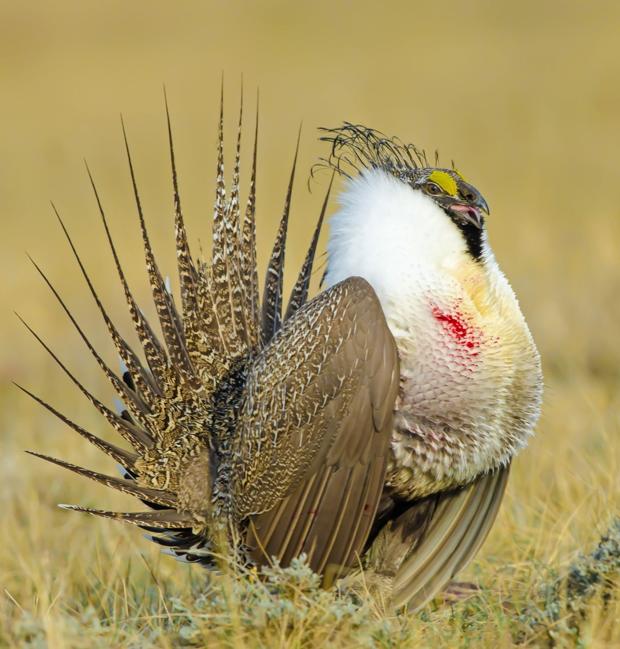
A chicken-sized bird is ruffling a lot of feathers these days.
The
U.S. Fish and Wildlife Service faces a court-ordered Sept. 30 deadline
to announce whether it believes sage grouse need federal protection by
designating them a threatened or endangered species. It is an issue that
strikes close to home for many Montana and Wyoming residents —
especially hunters.
Why should you care? Well for one
thing, sage grouse are seen as an indicator species. That means as the
sage grouse thrive, or fail to thrive, so too do other prairie-dwelling
species. For hunters, that includes animals like mule deer, pronghorns
and sharp-tailed grouse, which inhabit the same landscapes. For bird
watchers it includes species like golden eagles, hawks and falcons.
“A
new cliche emerging now is: ‘What’s good for the bird is good for the
herd,’” said Ed Arnett, of the Theodore Roosevelt Conservation
Partnership, at a gathering of outdoor writers in Bozeman.
“We’re
trying to protect an entire ecosystem,” said Jim Lyons, deputy
assistant secretary of Land and Minerals Management for the Department
of Interior. “Forty years after the signing of the Endangered Species
Act, we’re on the verge of implementing the act as it was designed — to
prevent the listing of a species.”
Apparently the U.S.
Department of Agriculture agrees. The agency recently announced an
investment of $211 million in Farm Bill funding for sage grouse projects
involving private landowners. All of that attention may be paying off, a
recent survey found that the number of male sage grouse per breeding
ground was the highest it’s been since 1970 — 25.5 males per lek, or
courtship grounds.
In Montana
About
one-third of Montana contains important sage grouse habitat, most of it
in the eastern part of the state, although there is also a sizable
population in the Dillon area.
“We have about 18 percent
of the world’s population of sage grouse,” said Tim Baker, Montana Gov.
Steve Bullock’s policy adviser for natural resources. “Many of our
populations are at low risk. In Montana we still do benefit from having
significant intact habitat” and secure populations of birds.
Although
sage grouse are sensitive to development such as power lines, road
building and oil and gas drilling, “livestock grazing is not seen as a
disturbance,” Lyons said. Oil and gas drilling are a big threat to sage
grouse, but “more than half of the areas that are high priority for oil
and gas development are not in priority sage grouse habitat,” he added.
Much
of Montana’s sage grouse population, about 66 percent, lives on private
land. Only 8 to 9 percent reside on state land, the rest live on
federal lands – mostly the Bureau of Land Management. The BLM has
already drawn up its plans to preserve 3.5 million acres of priority
sage grouse habitat in Montana and the Dakotas. The BLM’s plans will
still allow some gravel pits to be created, bentonite mining to continue
and will not restrict motorized use on designated and open routes. But
they do require “no surface occupancy” for oil and gas drilling in
priority habitat.
“There was a rumor (roads) would be
closed. That’s not true,” said Jamie Connell, BLM’s Montana-Dakotas
director. “We will try to maintain this Western working landscape.”
The
state of Montana also has crafted a sage grouse management plan. The
USFWS is reviewing the plans to determine whether adequate protections
are in place to preclude listing sage grouse as threatened or
endangered.
“I don’t think we’ve reached a perfect
solution,” Connell said. “But I feel very good about what we’re handing
over to the Fish and Wildlife Service.”
Complex issue
Although
coordinating a response to protect sage grouse habitat on the state
scale is difficult, consider that the U.S. Fish and Wildlife Service is
examining plans across 11 states involving an alphabet soup of state and
federal agencies.
“This is not a one-size fits all plan,” Lyons said. “Montana, Wyoming and Idaho all have different plans.”
No comments:
Post a Comment